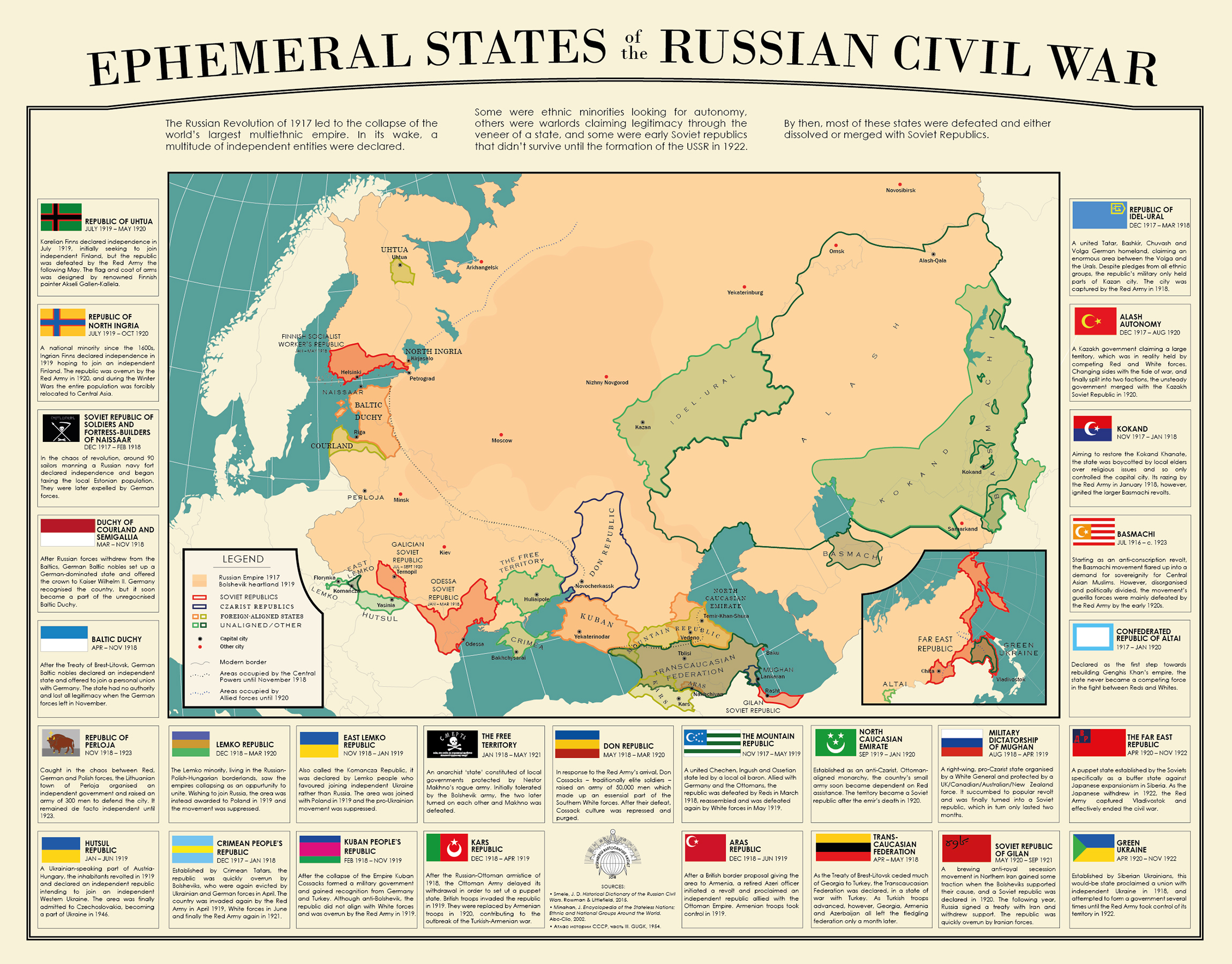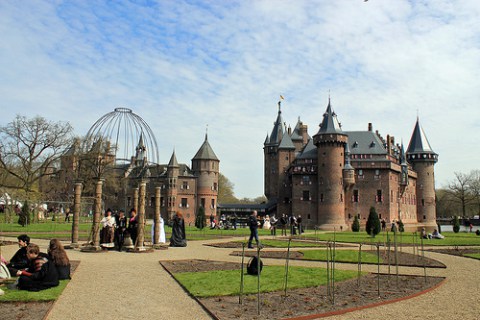After the Russian Revolution of 1917, many states were proclaimed in the territory of the former Russian Empire. Some were ethnic minorities looking for autonomy. Others were warlords claiming legitimacy through the veneer of a state. Others yet were proto-Soviet republics that were later incorporated into the USSR.
“PisseGuri82” has created a beautiful map of these ephemeral states of the Russian Civil War.

The map is not complete. So many states were declared between the fall of the Russian Empire and the consolidation of the Soviet Union that it’s almost impossible to capture them all in a single graphic. The artist writes, “This map is about the ones most people haven’t heard of.”
Some would say these are not all actual states, and that is kind of the point. The Kuban Republic was internationally recognized and had ambassadors and a large army; Basmachi was a very loose organization of guerrilla fighters, Naissaar was simply a band of corrupt soldiers with a freaky flag and Green Ukraine was never even properly declared independent. Many other local governments lie somewhere on the sliding scale between a regional council that printed money and passed laws and an actual independent government on the international scene.
Below are the country descriptions from the graphic.
- Republic of Uhtua (July 1919–May 1920): Karelian Finns eclared independence in July 1919, initially seeking to join independent Finland, but the republic was defeated by the Red Amy the following May. The flag and coat of arms was designed by renowned Finnish painter Akseli Gallen-Kallela.
- Republic of North Ingria (July 1919–October 1920): A national minority since the 1600s, Ingrian Finns declared independence in 1919 hoping to join an independent Finland. The republic was overrun by the Red Army in 1920, and during the Winter Wars the entire population was forcibly relocated to Central Asia.
- Soviet Republic of Soldiers and Fortress-Builders of Naissaar (December 1917–February 1918): In the chaos of revolution, around ninety sailors manning a Russian navy fort declared independence and began taxing the local Estonian population. They were later expelled by German forces.
- Duchy of Courland and Semigallia (March–November 1918): After Russian forces withdrew from the Baltics, German Baltic nobles set up a German-dominated state and offered the crown to Kaiser Wilhelm II. Germany recognized the country, but it soon became a part of the unrecognized Baltic Duchy.
- Baltic Duchy (April–November 1918): After the Treaty of Brest-Litovsk, German Baltic nobles declared an independent state and offered to join a personal union with Germany. The state had no authority and lost all legitimacy when the German forces left in November.
- Republic of Perloja (November 1918–1923): Caught in the chaos between Red, German and Polish forces, the Lithuanian town of Perloja organized an independent government and raised an army of 300 men to defend the city. It was remained de facto independent until 1923.
- Hutsul Republic (January–June 1919): A Ukrainian-speaking part of Austria-Hungary, the inhabitants revolted in 1919 and declared an independent republic intending to join an independent Western Ukraine. The area was finally admitted to Czechoslovakia, becoming a part of Ukraine in 1946.
- Lemko Republic (December 1918–March 1920): The Lemko minority, living in the Russian-Polish-Hungarian borderlands, saw the empires collapsing as an opportunity to unite. Wishing to join Russia, the area was instead awarded to Poland in 1919 and the movement was suppressed.
- Crimean People’s Republic (December 1917–January 1918): Established by Crimean Tatars, the republic was quickly overrun by Bolsheviks, who were again evicted by Ukrainian and German forces in April. The country was invaded again by the Red Army in April 1919, White forces in June and finally the Red Army again in 1921.
- East Lemko Republic (November 1918–January 1919): Also called the Komancza Republic, it was declared by Lemko people who favored joining independent Ukraine rather than Russia. The area was joined with Poland in 1919 and the pro-Ukrainian movement was suppressed.
- Kuban People’s Republic (February 1918–November 1919): After the collapse of the empire, Kuban Cossacks formed a military government and gained recognition from Germany and Turkey. Although anti-Bolshevik, the republic did not align with White forces and was overrun by the Red Army in 1919.
- The Free Territory (January 1918–May 1921): An anarchist “state” constituted of local governments protected by Nestor Makhno’s rogue army. Initially tolerated by the Bolshevik army, the two later turned on each other and Makhno was defeated.
- Kars Republic (December 1918–April 1919): After the Russian-Ottoman armistice of 1918, the Ottoman Army delayed its withdrawal in order to set up a puppet state. British troops invaded the republic in 1919. They were replaced by Armenian troops in 1920, contributing to the outbreak of the Turkish-Armenian War.
- Don Republic (May 1918–March 1920): In response to the Red Army’s arrival, Don Cossacks — traditionally elite soldiers — raised an army of 50,000 men, which made up an essential part of the Southern White forces. After their defeat, Cossack culture was repressed and purged.
- The Mountain Republic (November 1917–May 1919): A united Chechen, Ingush and Ossetian state led by a local oil baron. Allied with Germany and the Ottomans, the republic was defeated by Reds in March 1918, reassembled and was defeated again by White forces in May 1919.
- Aras Republic (December 1918–June 1919): After a British border proposal giving the area to Armenia, a retired Azeri officer initiated a revolt and proclaimed an independent republic allied with the Ottoman Empire. Armenian troops took control in 1919.
- North Caucasian Emirate (September 1919–January 1920): Established as an anti-Tsarist, Ottoman-aligned monarchy, the country’s small army soon became dependent on Red assistance. The territory became a Soviet republic after the emir’s death in 1920.
- Transcaucasian Federation (April–May 1918): As the Treaty of Brest-Litovsk ceded much of Georgia to Turkey, the Transcaucasian Federation was declared, in a state of war with Turkey. As Turkish troops advanced, however, Georgia, Armenia and Azerbaijan all left the fledging federation only a month later.
- Military Dictatorship of Mughan (August 1918–April 1919): A right-wing, pro-Tsarist state organized by a White [colonel] and protected by a UK/Canadian/Australian/New Zealand force. It succumbed to popular revolt and was finally turned into a Soviet republic, which in turn only lasted two months.
- Soviet Republic of Gilan (May 1920–September 1921): A brewing anti-royal secession movement in Northern Iran gained some traction when the Bolsheviks supported their cause and a Soviet republic was declared in 1920. The following year, Russia signed a treaty with Iran and withdrew support. The republic was quickly overrun by Iranian forces.
- Republic of Idel-Ural (December 1917–March 1918): A united Tatar, Bashkir, Chuvash and Volga German homeland, claiming an enormous area between the Volga and the Urals. Despite pledges from all ethnic groups, the republic’s military only held parts of Kazan city. The city was captured by the Red Army in 1918.
- Alash Autonomy (December 1017–August 1920): A Kazakh government claiming a large territory, which was in reality held by competing Red and White forces. Changing sides with the tide of the war, and finally split into two factions, the unsteady government merged with the Kazakh Soviet Republic in 1920.
- Kokand (November 1917–January 1918): Aiming to restore the Kokand Khanate, the state was boycotted by local elders over religious issues and so only controlled the capital city. Its razing by the Red Army in January 1918, however, ignited the larger Basmachi revolts.
- Basmachi (July 1916–c. 1923): Starting as an anti-conscription revolt, the Basmachi movement flared up into a demand for sovereignty for Central Asian Muslims. However, disorganized and politically divided, the movement’s guerrilla forces were mainly defeated by the Red Army by the early 1920s.
- Confederated Republic of Altai (1917–January 1920): Declared as the first step toward rebuilding Genghis Khan’s empire, the state never became a competing force in the fight between Reds and Whites.
- The Far East Republic (April 1920–November 1922): A puppet state established by the Soviets specifically as a buffer state against Japanese expansionism in Siberia. As the Japanese withdrew in 1922, the Red Army captured Vladivostok and effectively ended the civil war.
- Green Ukraine (April 1920–November 1922): Established by Siberian Ukrainians, this would-be state proclaimed a union with independent Ukraine in 1918 and attempted to form a government several times until the Red Army took control of its territory in 1922.





1 Comment
Add YoursMany thanks to PisseGuri82 and Nick for this amazing map and article!